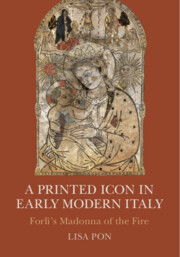Book contents
- Frontmatter
- Contents
- List of Illlustrations
- Acknowledgments
- A Printed Icon in Early Modern Italy
- Part I Thing
- Part II Emplacement
- Three Miracle: The Fire of February 4, 1428
- Four Domestic Display: Lombardino da Ripetrosa's Schoolhouse
- Five Ecclesiastical Enshrinement: The Cathedral of Forlì
- Part III Mobilities
- Notes
- Selected Bibliography
- Index
Five - Ecclesiastical Enshrinement: The Cathedral of Forlì
from Part II - Emplacement
Published online by Cambridge University Press: 05 April 2015
- Frontmatter
- Contents
- List of Illlustrations
- Acknowledgments
- A Printed Icon in Early Modern Italy
- Part I Thing
- Part II Emplacement
- Three Miracle: The Fire of February 4, 1428
- Four Domestic Display: Lombardino da Ripetrosa's Schoolhouse
- Five Ecclesiastical Enshrinement: The Cathedral of Forlì
- Part III Mobilities
- Notes
- Selected Bibliography
- Index
Summary
And so in reverence to this supreme power, they built vast and impressive houses [case], which they further tried to distinguish in name as well as in form from those in which people dwelled; and they called them “temples” [templi].
BoccaccioBoccaccio makes clear the general distinction between house and church: the former is a structure for mundane human living, whereas the latter, separated by name as well as form, serve as dwellings for the divine. Forlì's Little Church of the Miracle is a rare case in which that distinction was bridged, by transfiguring Lombardino da Ripetrosa's lost house into a church consecrated four centuries after the February 4, 1428 fire had destroyed it. Immediately after the fire had been fully extinguished, there was not yet any thought of building a church in the smouldering remains of Lombardino's schoolhouse. Rather, the unburned woodcut, now recognized as a miraculous image, was quickly removed and taken to a church, that space distinct from ordinary houses, and not just any church but Forlì's cathedral.
Churches specially built to honor other miraculous Marian icons at Todi, Prato, and Montepulciano in the late fifteenth and sixteenth centuries were given autonomy from local parish and episcopal authority and put under direct communal control through papal fiat, but the situation in Forlì was more complex. By being placed in Forlì's cathedral, the seat of the city's bishop, the Madonna of the Fire and its emerging cult was supported by pope, bishop, and commune. Negotiations between these three parties were constant, and at times fraught, during the centuries-long construction and furnishing of the cathedral and the chapel for the Madonna of the Fire within it. Issued just four decades after the fire, Pope Paul II's 1468 bull granting indulgences to devoted visitors to the chapel is perhaps our earliest indication of balancing of powers: the pope expressly forbade Forlì's bishop, its chapter (which elected the bishop), or the chapel's rector from spending these pilgrims' donations on anything but the repair, maintenance, or decoration of the chapel itself.
- Type
- Chapter
- Information
- A Printed Icon in Early Modern ItalyForlì's Madonna of the Fire, pp. 121 - 138Publisher: Cambridge University PressPrint publication year: 2015



